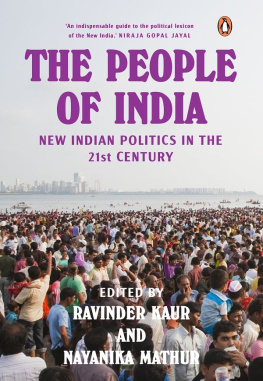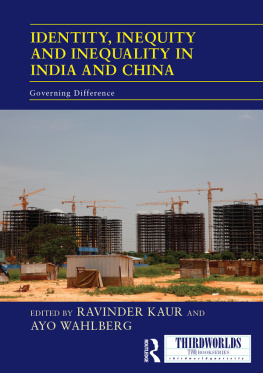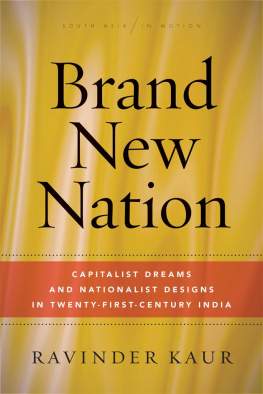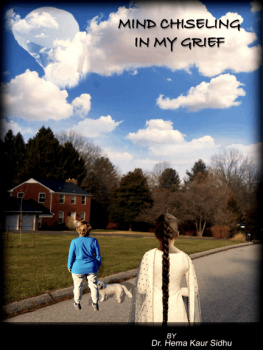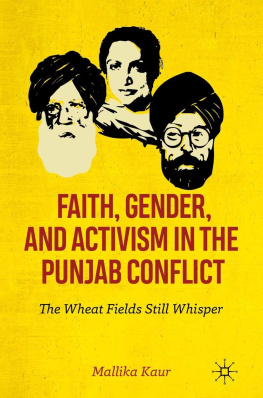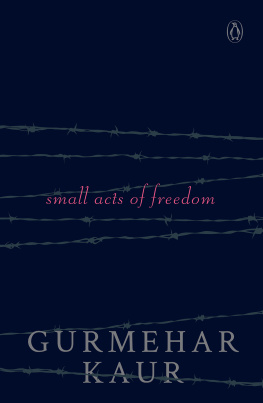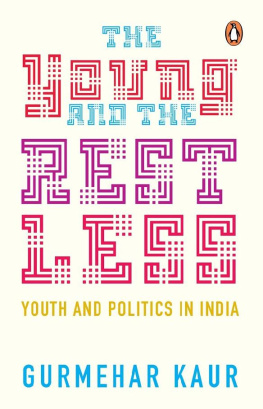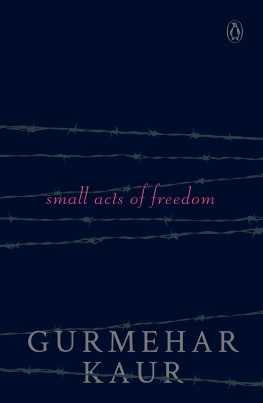Ravinder Kaur - The People of India
Here you can read online Ravinder Kaur - The People of India full text of the book (entire story) in english for free. Download pdf and epub, get meaning, cover and reviews about this ebook. year: 2022, publisher: Penguin Group, genre: Politics. Description of the work, (preface) as well as reviews are available. Best literature library LitArk.com created for fans of good reading and offers a wide selection of genres:
Romance novel
Science fiction
Adventure
Detective
Science
History
Home and family
Prose
Art
Politics
Computer
Non-fiction
Religion
Business
Children
Humor
Choose a favorite category and find really read worthwhile books. Enjoy immersion in the world of imagination, feel the emotions of the characters or learn something new for yourself, make an fascinating discovery.
- Book:The People of India
- Author:
- Publisher:Penguin Group
- Genre:
- Year:2022
- Rating:3 / 5
- Favourites:Add to favourites
- Your mark:
- 60
- 1
- 2
- 3
- 4
- 5
The People of India: summary, description and annotation
We offer to read an annotation, description, summary or preface (depends on what the author of the book "The People of India" wrote himself). If you haven't found the necessary information about the book — write in the comments, we will try to find it.
Ravinder Kaur: author's other books
Who wrote The People of India? Find out the surname, the name of the author of the book and a list of all author's works by series.
The People of India — read online for free the complete book (whole text) full work
Below is the text of the book, divided by pages. System saving the place of the last page read, allows you to conveniently read the book "The People of India" online for free, without having to search again every time where you left off. Put a bookmark, and you can go to the page where you finished reading at any time.
Font size:
Interval:
Bookmark:


NAYANIKA MATHUR

PENGUIN BOOKS

PENGUIN BOOKS
The activist, the outsider, the devotee, the mob, antipolitical politics, bureaucratic subservience, a docile media, and (let me add) bulldozer raj, beneficiary citizenshipthere have been many remarkable novelties in Indian politics in recent years. This splendid volume examines these novelties in a deeply historical and broadly global frame of the emergence of the people of India.
Partha Chatterjee, Professor Emeritus of Anthropology,
Columbia University, New York
An indispensable guide to the political lexicon of the New India. The essays in this imaginatively conceived volume offer compelling portraits of the people at the heart of a new democratic politicsfrom the kisan and the bhakt to the Aam Aadmi and the Old Woman.
Niraja Gopal Jayal, Avantha Chair,
Kings India Institute, Kings College London
To
The People of India
SATISH DESHPANDE
THIS BOOK COULD be described as timely. There is nothing wrong with the adjective, and in most contexts, it would be the proper word of praise for a work that is occurring... at a fitting or suitable time; seasonable, opportune [or] well-timed, as the Oxford English Dictionary puts it. But if one is living in India in 2022, the overwhelming urgency of the politics of our present rudely pushes every other topic aside to occupy centre stage. Timely is too mild a term for the vigorous way in which this volume fits the need of the hour.
Ironically, however, even the best-timed interventions can be overtaken by newer events. The Covid-19 pandemic was not part of the plan for this collection, and yet it is having a profound impact on politics not just in India but across the world. A presentist bias is inevitable here, and though it seems very unlikely, it is possible that, decades hence, this brief viral interregnum will seem like a minor local aberration. But today, it is impossible to overlook the decisive way in which the pandemic has transformed everyday life and altered the meanings of most things, including the New Indian Politics and its figures discussed in this book. I will use the privilege granted to me in this foreword to list some of the emerging arguments about the political fallout of the pandemic and its possible implications for the concerns of this volume.
It is now widely recognized that, in the past decade, large parts of the world have been dealing with not one but two pandemics. Popular authoritarianism has not spread as widely, but it has been more virulent than Covid-19 in terms of the immediate shocks and long-term realignments it has brought about in the societies and states it has infected. How has the medical pandemic affected the course of the political one? Three main consequences have been observed so far.
The most immediate and most visible effect by far has been on popular protest. This was highlighted dramatically in the sudden halt of the campaign against the Citizenship (Amendment) Act, 2019, the strongest challenge faced by the Modi regime until then. It was also present in more subtle form with the farmers agitation as murmurings (including among supporters) at the apparently casual attitude towards Covid protocols at the various protest sites. This raises questions about the spatiality of protest politics, which seems to rely more than other kinds of politics on physical proximity, large congregations and significant sites and places. This is even more true in the new Indian normala virulent right-wing chauvinism that is now so confident of itself that it can afford to brush aside accumulated layers of explicit and implicit norms about political conduct. Somehow, it seems that opposition to such regimes is required to meet higher standards of public presenceit is required, so to speak, to be visibly peopled.
Associated with the drastic shrinking of forms of public protest are two other developments that need consideration. The first concerns the now familiar phenomenon of online politics, sometimes called clicktivism. What happens to this form of digital activism when it becomes (more or less) the only or the most common form of participatory politics? We are still to understand the shifts in Indian social media in recent times. During the past decade, most popular apps and sites were prominent as vehicles speeding ideologies of hate and sycophancy to their desired destinations. What are we to make of the fact that dissenting views seemed to gain a small foothold in the social media around the time when modes of offline protest were prohibited by the pandemic? Is this just an illusion, an effect produced by right-wing, hate-mongering IT cells easing up on their activity, having achieved most of what they set out to do? Or is something really changing in the social media world?
The sudden and prolonged disappearanceliterally, an inability to appearof public protest gives rise to further misgivings about its future. Now that the coronavirus is known to be capable of reappearing repeatedly in mutated avatars, we have to reckon with the realization that some of the drastic pandemic-justified life changes we have accepted may not really be temporary. Has the prolonged experience of the pandemic shifted the meaning of the phrase social distancing from the register of prophylaxis to that of prophecy? What will happen to the everyday forms of political practicethe mundane ways in which we assert and affirm our sense of connectedness to otherswhen every other is (also) a bearer of risk? Will new forms of sociability emerge to overcome the constraints of physical distancing and compensate for the loss of the incalculable synergies of congregation?
A second consequence of the superimposition of Covid on authoritarianism found in many parts of the world, including India, is the emergence of a sort of pandemic patriotism. The surface effects are broadly similar and include the resurgence of nationalist feeling, which spills over into (renewed or new-found) support for national leaders. But the underlying sources of these surface effects can be very different. The lifeboat mentality may prompt a my country first attitude in a global crisis and bring approval for leaders who are seen to act aggressively to defend national interests. An example is President Trump and his brazen attempts to convert a particular vaccine into a US monopoly. A different kind of solidarity is provoked by the natural calamity or war-like situation that the pandemic seemed to be. Examples of this kind of patriotism are seen in different forms in countries like China and Italy.
Whatever its particular source, the rise of pandemic patriotism shrinks the space for dissent and cements the popularity of national leaders who are already in power. Surprisingly, the public seems to be remarkably tolerant of mistakes and even incompetence in this context, recognizing the enormous challenge that a public health crisis of this magnitude poses. In such a context, it is all too easy for those in power to harness the pandemic to their political agendas and reap the benefits of this odd honeymoon period as long as it lasts. This is what we have seen in India, though there were times when public anger seemed to run high. As with demonetization, we are yet to understand the dynamics of such events and their strongly counter-intuitive outcomes. In short, the pandemic created a self-evidently heroic situation in which those in power could (for an indefinite time) effortlessly assume the role of saviours. It had the reverse effect on opponents and dissenters, forcing them to tread carefully in order to avoid being accused of (in the traditional phrase) politicizing a national crisis.
Font size:
Interval:
Bookmark:
Similar books «The People of India»
Look at similar books to The People of India. We have selected literature similar in name and meaning in the hope of providing readers with more options to find new, interesting, not yet read works.
Discussion, reviews of the book The People of India and just readers' own opinions. Leave your comments, write what you think about the work, its meaning or the main characters. Specify what exactly you liked and what you didn't like, and why you think so.

